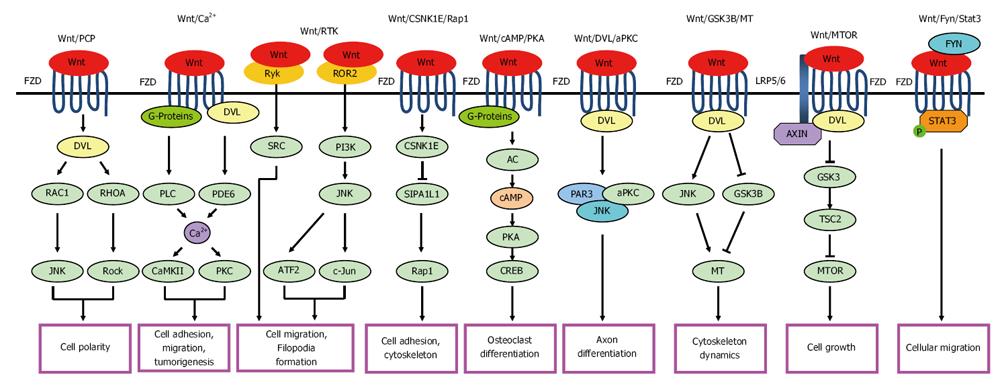Copyright
©The Author(s) 2016.
World J Gastroenterol. Sep 7, 2016; 22(33): 7486-7499
Published online Sep 7, 2016. doi: 10.3748/wjg.v22.i33.7486
Published online Sep 7, 2016. doi: 10.3748/wjg.v22.i33.7486
Figure 2 Non-canonical wingless/int-1 signaling pathway.
Non-canonical Wnt pathways are mediated by several possible mechanisms which are independent of the CTNNB1-TCF/LEF transcriptional function, including: (1) Wnt/PCP pathway; (2) Wnt/Ca2+ pathway; (3) Wnt/RTK pathway; (4) Wnt/CSNK1E/Rap1 pathway; (5) Wnt/cAMP/PKA pathway; (6) Wnt/DVL/aPKC pathway; (7) Wnt/GSK3β/MT pathway; (8) Wnt/MTOR pathway; and (9) Wnt/FYN/STAT3 pathway. Lines ending with arrows or bars indicate activating or inhibitory effects respectively. Wnt: Wingless/int-1; CTNNB1: Catenin beta 1; TCF/LEF: T-cell-specific transcription factor/lymphoid enhancer binding factor; PCP: Planar cell polarity; RTK: Receptor tyrosine kinases; CSNK1E: Casein kinase I epsilon; cAMP: Cyclic adenosine monophosphate; PKA: Protein kinase A; DVL: Disheveled; aPKC: Atypical protein kinase C; GSK3β: GSK3B, glycogen synthase kinase 3 beta; MTOR: Mechanistic target of rapamycin; FYN: FYN proto-oncogene, Src family tyrosine kinase; STAT3: Signal transducer and activator of transcription 3.
- Citation: Liu LJ, Xie SX, Chen YT, Xue JL, Zhang CJ, Zhu F. Aberrant regulation of Wnt signaling in hepatocellular carcinoma. World J Gastroenterol 2016; 22(33): 7486-7499
- URL: https://www.wjgnet.com/1007-9327/full/v22/i33/7486.htm
- DOI: https://dx.doi.org/10.3748/wjg.v22.i33.7486









